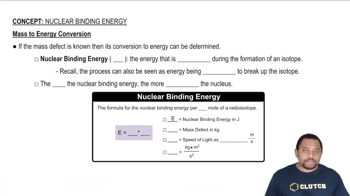Here are the essential concepts you must grasp in order to answer the question correctly.
Nuclear Reactions
Nuclear reactions involve changes in an atom's nucleus and can result in the transformation of elements. They include processes such as fission, where a heavy nucleus splits into lighter nuclei, and fusion, where light nuclei combine to form a heavier nucleus. Understanding the basic principles of these reactions is essential for balancing nuclear equations.
Recommended video:
Balancing Nuclear Equations
Balancing nuclear equations requires ensuring that both the mass number and atomic number are conserved during the reaction. This means that the total number of protons and neutrons before the reaction must equal the total after the reaction. Identifying the missing particles, such as neutrons or protons, is crucial for achieving balance.
Recommended video:
Balancing Chemical Equations
Isotopes
Isotopes are variants of a particular chemical element that have the same number of protons but different numbers of neutrons, resulting in different mass numbers. In nuclear reactions, isotopes play a significant role as they can participate in fission or fusion processes. Recognizing the isotopes involved helps in accurately writing and balancing nuclear equations.
Recommended video:




